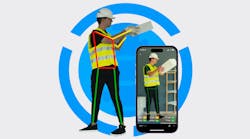How SoterTask’s unique AI-driven vision processing technology facilitates creative problem-solving to mitigate the risk of injury.
The fusion of human creativity and machine intelligence has proven to be a winning combination, as research indicates that collaborative problem-solving involving both humans and AI can outperform either party in isolation.
When we think about AI, workplace safety and injury prevention might not be the first thing to spring to mind. But those of us who work in this space everyday know that it’s a complex problem, especially in the context of ergonomics. The human body and its biomechanics is intricately multifaceted and risk reduction can sometimes seem like an almost impossible task.
Luckily, health and safety people are creative geniuses; constantly solving problems, designing solutions and improving safety through their own ingenuity. The question is, how can we incorporate AI-driven technologies into our creative processes to drive interventions that are even more effective?
How Human Ingenuity Drives Injury Prevention
Analyzing injury data from diverse sources is essential in pinpointing potential risks, but preventing injuries requires more than data alone. As safety professionals, we're familiar with the hierarchy of controls, which guides our approach to risk reduction. However, creative problem-solving remains indispensable in addressing specific high-risk areas in work processes.
Consider a pallet manufacturing company struggling with elbow and shoulder injuries among their workers. After employing the SoterCoach wearable, they discovered that a repetitive movement at a particular production line stage was causing these injuries. The company recognized that data was only part of the solution, and creativity was necessary to truly address the issue.
The team devised an innovative engineering control - a new prototype tool aimed at reducing strain on workers. Excited by their idea, they understood that further refinement and collaboration were needed to ensure the tool's effectiveness in enhancing workplace safety. In this way, creative problem-solving and teamwork play a vital role in tackling safety challenges, complementing the insights provided by data analysis.
Engaging Employees in the Creative Process
The creative process often involves collaboration, testing ideas, and refining them based on feedback. Involving frontline workers enhances problem-solving and uncovers valuable insights.
In the pallet manufacturing example, the company engaged employees to test and provide feedback on the prototype tool, refining its design and finalizing recommendations for improved workplace safety.
Using SoterTask to Facilitate Iterative Creative Processes
With various tools available, we can identify problem areas, quantify hazards, and even coach workers. These technologies are useful for automating data analysis, scaling processes, and improving worker techniques.
Technology, like SoterTask, can't replace human creativity. Instead, it facilitates creative problem-solving.
In the pallet manufacturing example, SoterTask's real-time video analysis and comparison features helped refine the new tool, capturing the risk reduction potential and enabling continuous improvement of the design.
How SoterTask Helps Justify Injury Prevention Investment Costs
Not only did SoterTask help the organization refine and improve their new tool, but it also provided them with valuable quantifiable data. Thanks to this data, they were able to justify the investment in implementing the new tool across all their facilities.
The report produced by SoterTask showed a significant reduction in hazardous arm movements during pallet repair tasks - from over 100 per hour to less than 10. The data from SoterTask showed that the new tool would also result in a 30% reduction in pallet repair time, translating into cost savings and improved efficiency.
Combining Human Creativity and AI Technology
When humans and AI work together, it can lead to some powerful results, especially when it comes to tackling complex workplace safety problems. SoterTask is a prime example. While AI tools like SoterTask can provide valuable data analysis and streamline the creative process, it's important to recognize that human ingenuity is a key factor in developing truly innovative solutions.
By combining the strengths of both humans and technology, we can generate novel ideas and achieve better outcomes than either could alone.
ABOUT SOTER ANALYTICS
Soter Analytics, a worldwide leader in safety technology solutions, offers a strategic approach to workplace safety for its partners. Utilizing cutting-edge, AI-driven wearable devices, sensor-free video analysis, and a team of injury prevention specialists and data evaluation experts, Soter proactively enhances safety, leading to increased productivity, improved workplace efficiency, and stronger safety culture.
Author: Toni-Louise Gianatti
Toni-Louise Gianatti has a 25-year background in biomechanically efficient movement and posture education. Over the past five years, she has been engaged in research and publication endeavours, disseminating articles worldwide that examine the advantages, challenges, and results of utilizing wearable technology and artificial intelligence for the purpose of injury prevention among frontline workers.
